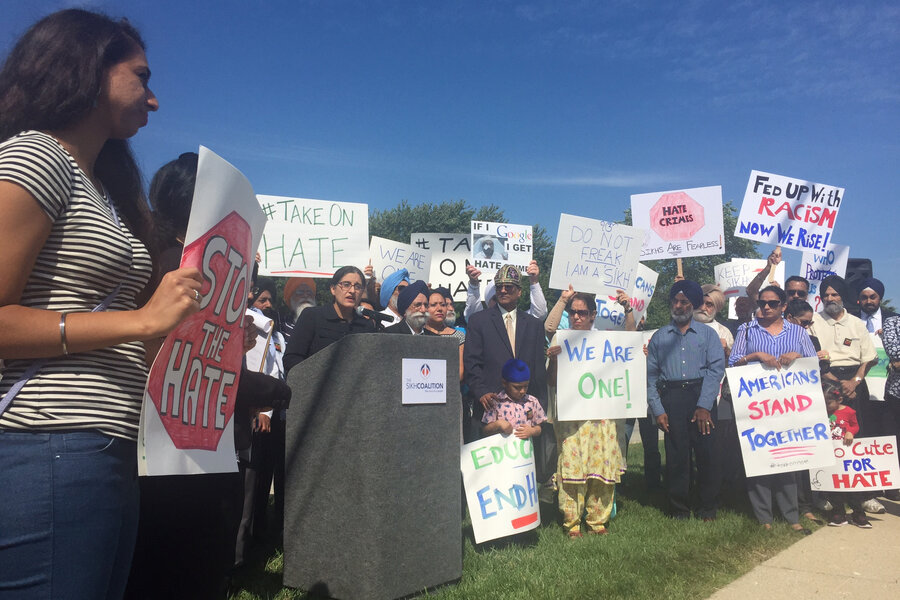Tired of being targeted, America's Sikhs are standing up for their identity
Loading...
| Los Angeles
At the Gurdwara of Los Angeles, a small group of Sikh temple-goers move quietly between prayer and community rooms after work on Tuesday. They are here to eat and pray, but also to share their concerns about what many see as growing violence against their religion's members, easily identifiable by their traditional beards and turbans. Saturday’s attack on an elderly Sikh farmhand in Fresno, which police have called a hate crime, has heightened their concerns.
“We are very worried,” says Sukhwant Singh Sandhu, a 70-year-old grandfather who came to the United States from India 30 years ago. He is now a US citizen and retired six months ago. But, he says, during the many years he worked at convenience stores and gas stations, he regularly shaved his beard to avoid drawing attention to his appearance. “I am now growing this beard for six months,” he says sipping sweet tea with a smile.
Many Sikhs say after the attacks on 9/11, anyone who wore beards or religious headgear became a target for hostility, with attackers rarely making distinctions between various religions such as Islam or Sikhism.
Indeed, the Sikh Coalition, a national civil rights group, was founded on Sept. 11, 2001, to counter what activists say was an immediate backlash against “anyone who appeared foreign,” says Harsimran Kaur, legal director of the coalition.
"It's definitely a very scary and hostile time,” she says. “After the attacks in Paris and San Bernardino, as well as all of this rhetoric by politicians about Islamophobia and xenophobia, all this has emboldened people who feel biases to act out,” she says.
The atmosphere right now is as tense as she can remember, she says. The group has received nearly three times as many requests for help during the first three weeks of December as the same time period in the prior two years.
“It feels like open season on anyone who looks different,” says Prabhjot Singh, a professor of medicine at Mount Sinai in New York. He was attacked by a group of young men near Central Park in 2013 and suffered a fractured jaw as well as dislocated teeth.
“There is an atmosphere of permissiveness in this hostility,” he says adding that he continues to hear the kind of insults hurled at him during the attack, comments comparing him to Osama bin Laden and calling him a terrorist.
Statistics on hate crimes against Sikhs are sketchy at best, say coalition officials, because the federal government only began tracking them in the past year. Documenting the community itself has been difficult, they point out. While the religion is considered one of the globe’s five largest, with between 25 and 27 million worldwide, estimates of the US population are rough, ranging from 500,000 to 700,000 – half of which live in California.
There are signs that the community is beginning to assert its distinct identity and rights. Hapreet Singh Saini, who lost his mother in the mass shooting in Oak Creek, Wis., in 2012 when he was 18, was the first Sikh American to testify in front of Congress after the tragedy. He implored Congress to recognize her religious identity, because “she deserves her rights,” he says.
In addition, while some Sikhs have decided to publicly play down their religious affiliation, earlier this month the US Army issued the first accommodation for a Sikh soldier in a combat position. It will allow Capt. Simratpal Singh to temporarily grow out his beard and wear a turban – actions that have historically been at odds with the military’s strict grooming standards.
Last year, a Sikh accountant won a settlement from the federal government that would allow her to bring her kirpan, a small, sheathed ceremonial dagger to be worn at all times as an article of faith, to work at federal buildings. As a result of her case, the Department of Homeland Security’s Federal Protective Service set up a procedure by which Sikhs could apply for religious accommodations to carry their kirpans into federal buildings. DHS admitted no wrongdoing in the settlement.
Before Kawal Tagore’s case, the government “essentially made Sikhs choose between their faith and their ability to serve the country honorably,” Daniel Blomberg, legal counsel for the Becket Fund for Religious Liberty in Washington, told the Monitor at the time.
Those at the California temple talk about steps they’ve taken to appear more mainstream. Pawanjot Kaur, says after 9/11 her father decided to change the style of his turban, to make it look “less turban-y.” She says many Sikh men she knows have switched to baseball caps.
“People are just hating on us,” says Ms. Kaur, holding her 3-month-old in her arms. She recalls an incident several years ago on a city bus. The driver had a long white beard and wore the traditional Sikh turban. “These guys just said, ‘Here is Osama bin Laden driving the bus,’ and began cursing and yelling at him,” she says, “and the driver couldn’t do anything but sit there until they got off.”
There is no doubt that discrimination and hate crimes against Sikhs have increased, says psychiatrist Carole Lieberman, author of “Coping with Terrorism: Dreams Interrupted.”
“This is happening because the Sikh culture is poorly understood by most people,” she says via e-mail, adding, “especially because our fear is making us blind to differences amongst people who look different than we do.”
It is not just Islamophobia that is increasing, she notes, but xenophobia. “All strangers feel threatening to us because, as terrorism crosses from foreign countries to America, we are becoming more overwhelmed with fear. People are so angry that the American way of life is being disturbed, that to some, it feels good to commit a hate crime – even if they have mistaken the target of their hate.”







